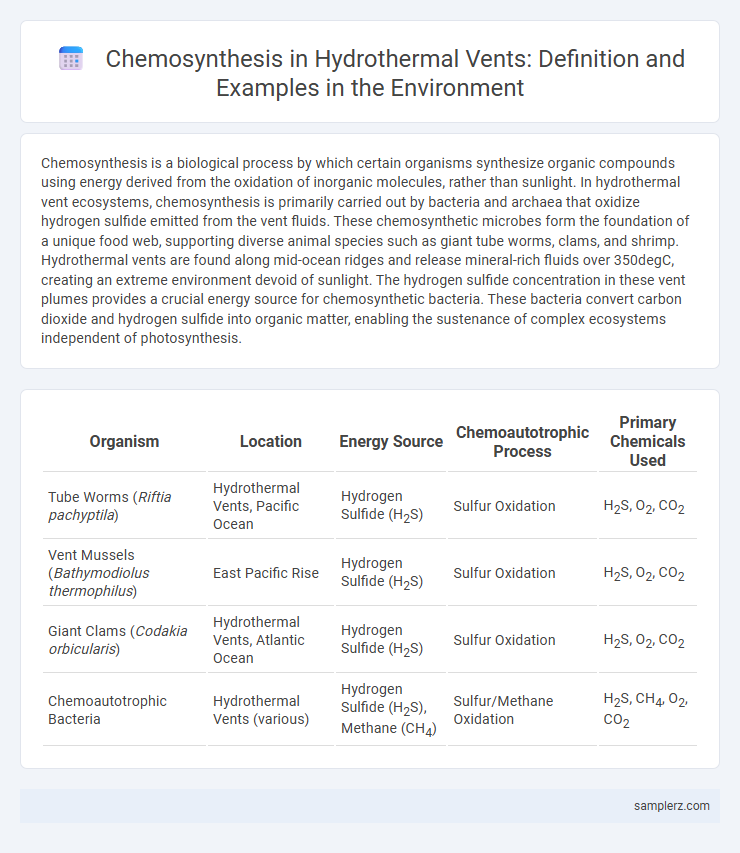Chemosynthesis is a biological process by which certain organisms synthesize organic compounds using energy derived from the oxidation of inorganic molecules, rather than sunlight. In hydrothermal vent ecosystems, chemosynthesis is primarily carried out by bacteria and archaea that oxidize hydrogen sulfide emitted from the vent fluids. These chemosynthetic microbes form the foundation of a unique food web, supporting diverse animal species such as giant tube worms, clams, and shrimp. Hydrothermal vents are found along mid-ocean ridges and release mineral-rich fluids over 350degC, creating an extreme environment devoid of sunlight. The hydrogen sulfide concentration in these vent plumes provides a crucial energy source for chemosynthetic bacteria. These bacteria convert carbon dioxide and hydrogen sulfide into organic matter, enabling the sustenance of complex ecosystems independent of photosynthesis.
Table of Comparison
| Organism | Location | Energy Source | Chemoautotrophic Process | Primary Chemicals Used |
|---|---|---|---|---|
| Tube Worms (Riftia pachyptila) | Hydrothermal Vents, Pacific Ocean | Hydrogen Sulfide (H2S) | Sulfur Oxidation | H2S, O2, CO2 |
| Vent Mussels (Bathymodiolus thermophilus) | East Pacific Rise | Hydrogen Sulfide (H2S) | Sulfur Oxidation | H2S, O2, CO2 |
| Giant Clams (Codakia orbicularis) | Hydrothermal Vents, Atlantic Ocean | Hydrogen Sulfide (H2S) | Sulfur Oxidation | H2S, O2, CO2 |
| Chemoautotrophic Bacteria | Hydrothermal Vents (various) | Hydrogen Sulfide (H2S), Methane (CH4) | Sulfur/Methane Oxidation | H2S, CH4, O2, CO2 |
Introduction to Chemosynthesis in Hydrothermal Vents
Chemosynthesis in hydrothermal vents is a biological process where bacteria convert inorganic molecules, such as hydrogen sulfide, into organic compounds using chemical energy. These bacteria form the base of the food chain, supporting diverse ecosystems in deep-sea vent communities that thrive without sunlight. Hydrothermal vent chemosynthesis exemplifies life's adaptation to extreme environments by utilizing chemical energy from Earth's geothermal activity.
The Unique Environment of Deep-Sea Vents
Deep-sea hydrothermal vents create a unique environment where chemosynthesis occurs, driven by bacteria that convert hydrogen sulfide and other minerals into organic compounds. These bacteria form the base of a complex ecosystem, supporting diverse organisms such as tube worms, clams, and shrimp that thrive without sunlight. The extreme pressure, high temperatures, and mineral-rich fluids of hydrothermal vents distinguish this habitat as one of the few ecosystems relying on chemical energy rather than photosynthesis.
Chemosynthetic Bacteria: Life’s Pioneers
Chemosynthetic bacteria at hydrothermal vents utilize chemical energy from hydrogen sulfide to produce organic compounds, supporting complex ecosystems in total darkness. These pioneering microbes convert inorganic molecules into energy through chemosynthesis, enabling life to thrive without sunlight on the ocean floor. Their metabolic processes form the foundation of unique vent communities, fueling diverse species such as tube worms and giant clams.
Hydrogen Sulfide: Fuel for Life Below
Hydrogen sulfide serves as the primary energy source for chemosynthesis in hydrothermal vent ecosystems, where specialized bacteria oxidize it to produce organic compounds sustaining diverse marine life. These bacteria convert hydrogen sulfide into chemical energy, forming the base of a unique food web independent of sunlight. The process supports thriving communities of tube worms, clams, and shrimp, showcasing an extraordinary adaptation to extreme deep-sea environments.
Symbiosis Between Tube Worms and Bacteria
Tube worms rely on a symbiotic relationship with chemosynthetic bacteria living in their trophosome, where bacteria convert hydrogen sulfide from hydrothermal vents into organic molecules, providing essential nutrients for the worm. This mutualistic interaction enables tube worms to thrive in extreme deep-sea environments devoid of sunlight. The chemosynthetic process sustains entire ecosystems around hydrothermal vents by supporting primary production in the absence of photosynthesis.
Giant Clams and Mussels: Chemosynthesis in Action
Giant clams and mussels at hydrothermal vents rely on chemosynthetic bacteria living in their tissues to convert hydrogen sulfide into organic carbon, sustaining their nutrition in the absence of sunlight. These symbiotic relationships enable these bivalves to thrive in extreme deep-sea environments where sunlight cannot penetrate. The chemosynthetic process supports entire hydrothermal vent ecosystems, demonstrating a key adaptation to energy production in dark ocean habitats.
Methanogenic Bacteria and Their Role
Methanogenic bacteria in hydrothermal vent ecosystems perform chemosynthesis by converting carbon dioxide and hydrogen into methane, providing a primary energy source for the vent community. These archaea thrive in extreme conditions, facilitating carbon cycling and sustaining diverse organisms through symbiotic relationships. Their metabolic processes drive the production of organic matter independent of sunlight, crucial for ecosystem stability in deep-sea environments.
Adaptations of Hydrothermal Vent Organisms
Hydrothermal vent organisms exhibit remarkable adaptations for chemosynthesis, relying on sulfur-oxidizing bacteria that convert hydrogen sulfide into organic compounds in the absence of sunlight. These organisms possess specialized proteins and enzymes that enable survival in extreme temperatures and high-pressure environments. Symbiotic relationships between vent animals and chemosynthetic bacteria facilitate efficient energy transfer and nutrient cycling in deep-sea ecosystems.
Ecological Impact of Chemosynthesis in the Deep Sea
Chemosynthesis in hydrothermal vent ecosystems supports unique biological communities by converting inorganic molecules like hydrogen sulfide into organic matter, sustaining diverse species independent of sunlight. This process forms the foundation of the deep-sea food web, enabling organisms such as tube worms, clams, and bacteria to thrive in extreme environments. The ecological impact extends to global biogeochemical cycles by influencing carbon fixation and nutrient flow in deep ocean habitats.
Future Research and Conservation of Vent Ecosystems
Future research on chemosynthesis in hydrothermal vent ecosystems aims to unravel the complex microbial communities that drive energy production through sulfur and methane oxidation, enhancing our understanding of biogeochemical cycles. Advanced genomic and metabolomic techniques are essential to identify novel enzymes and pathways that support adaptation to extreme conditions, offering potential biotechnological applications. Conservation efforts must prioritize protecting these unique habitats from deep-sea mining and climate change impacts to preserve their biodiversity and ecological functions.

example of chemosynthesis in hydrothermal vent Infographic
 samplerz.com
samplerz.com